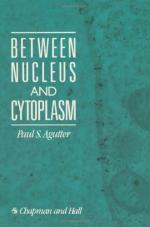|
This section contains 512 words (approx. 2 pages at 300 words per page) |

|
The cytoplasm of a prokaryotic cell is everything that is present inside the bacterium. In contrast to a eukaryotic cell, there is not a functional segregation inside bacteria. The cytoplasm houses all the chemicals and components that are used to sustain the life of a bacterium, with the exception of those components that reside in the membrane(s), and in the periplasm of Gram-negative bacteria.
The cytoplasm is bounded by the cytoplasmic membrane. Gram-negative bacteria contain another outer membrane. In between the two membranes lies the periplasm.
When viewed in the light microscope, the cytoplasm of bacteria is transparent. Only with the higher magnification available using the transmission electron microscope does the granular nature of the cytoplasm become apparent. The exact structure of the cytoplasm may well be different than this view, since the cytoplasm is comprised mainly of water. The dehydration necessary for conventional electron...
|
This section contains 512 words (approx. 2 pages at 300 words per page) |

|


